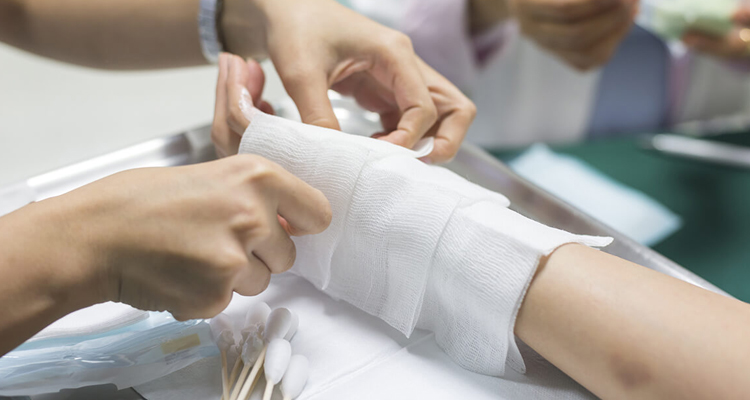
Management of Burn Patient
The management of burn patients involves a comprehensive approach aimed at stabilizing the patient, preventing complications, promoting wound healing, and restoring function. Here's an overview of the key aspects of burn patient management:
-
Initial Assessment and Stabilization:
- ABCs: Assess and manage the patient's airway, breathing, and circulation. Ensure that the patient has a patent airway and adequate oxygenation and ventilation.
- Fluid Resuscitation: Calculate the extent of fluid resuscitation needed using established formulas such as the Parkland formula. Administer intravenous fluids promptly to maintain adequate tissue perfusion and prevent hypovolemic shock.
- Assessment of Burn Severity: Determine the depth, extent, and location of the burns. Burns are classified based on their depth (superficial, partial-thickness, or full-thickness) and the percentage of total body surface area (TBSA) involved.
- Secondary Survey: Conduct a thorough secondary survey to assess for associated injuries, such as inhalation injury, trauma, or other medical conditions.
-
Wound Care and Dressing:
- Cooling: Immediately cool the burn with cool running water for 10-20 minutes to stop the burning process and reduce tissue damage. Do not use ice or ice water, as it can further injure the skin.
- Wound Assessment: Evaluate the burn wounds for depth, extent, and signs of infection. Partial-thickness and full-thickness burns may require debridement of necrotic tissue to promote wound healing.
- Wound Dressing: Apply appropriate wound dressings to protect the burn wound, prevent infection, and promote healing. Dressings may include non-adherent dressings, antimicrobial dressings, hydrogels, or silver dressings.
- Pain Management: Administer analgesics to manage pain associated with burn injuries. Use a multimodal approach, including opioids, nonsteroidal anti-inflammatory drugs (NSAIDs), and adjunctive therapies such as topical anesthetics or nerve blocks.
-
Infection Control:
- Antimicrobial Prophylaxis: Administer prophylactic antibiotics for deep or extensive burns, inhalation injury, or immunocompromised patients to prevent bacterial colonization and infection.
- Wound Cultures: Obtain wound cultures to identify the causative organisms and guide antibiotic therapy in infected burn wounds.
- Tetanus Prophylaxis: Ensure that the patient's tetanus immunization status is up to date and administer tetanus toxoid or immunoglobulin as needed.
-
Nutritional Support:
- Early Enteral Nutrition: Initiate enteral nutrition early to meet the increased metabolic demands and nutritional requirements of burn patients. Use specialized enteral formulas enriched with protein and micronutrients to promote wound healing and prevent malnutrition.
- Supplementation: Monitor for micronutrient deficiencies and provide appropriate vitamin and mineral supplementation as needed to support wound healing and immune function.
-
Surgical Management:
- Escharotomy/Fasciotomy: Perform escharotomies or fasciotomies as needed to relieve compartment syndrome and prevent ischemic injury in circumferential burns.
- Surgical Debridement: Perform surgical debridement of necrotic tissue to promote wound healing and prevent infection in deep or extensive burns. Consider early excision and grafting in severe burns to optimize outcomes.
-
Psychosocial Support:
- Psychological Support: Provide psychological support and counseling to burn patients and their families to address emotional distress, anxiety, depression, and post-traumatic stress disorder (PTSD) associated with burn injuries.
- Rehabilitation: Initiate early rehabilitation interventions, including physical therapy, occupational therapy, and psychological counseling, to maximize functional recovery and improve quality of life following burn injuries.
-
Long-Term Follow-Up:
- Scar Management: Monitor for hypertrophic scarring, contractures, and functional impairment in burn survivors. Implement scar management strategies, including pressure garments, silicone gel sheeting, and scar massage, to optimize scar outcomes and prevent deformities.
- Functional Restoration: Provide ongoing support and interventions to optimize functional outcomes and facilitate reintegration into society for burn survivors, including vocational rehabilitation, adaptive equipment, and social support services.
Burn patient management requires a multidisciplinary team approach involving burn surgeons, critical care specialists, nurses, physical therapists, occupational therapists, nutritionists, psychologists, and social workers. Collaboration among team members is essential to provide comprehensive care and support to burn patients throughout their recovery journey.
Book Appointment